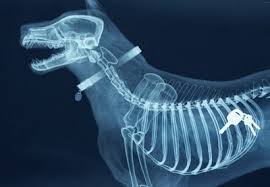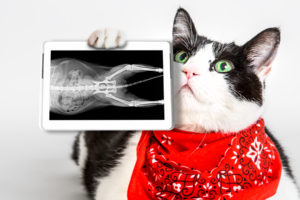
Why Pet XRAYS Make a Diagnostic Difference
 In order to properly diagnose an ailment, veterinarians rely on their hands to probe the body, eyes to assess condition, ears to listen to owners describe symptoms, diagnostic tests to determine blood and urine levels and XRAYS to see what lies beneath.
In order to properly diagnose an ailment, veterinarians rely on their hands to probe the body, eyes to assess condition, ears to listen to owners describe symptoms, diagnostic tests to determine blood and urine levels and XRAYS to see what lies beneath.
In many cases, Pet XRAYS can quickly and effectively uncover the source of health issues.
XRAYS are non-invasive procedure commonly used in Veterinary Medicine, providing painless yet swift diagnosis of many medical conditions.
And with the advent of digital XRAYS, resulting images can be examined within minutes, providing timely diagnosis for effective treatment along with much-needed relief for pets.

XRAYS can be used to look for bone fractures and signs of arthritis within joints and along the spine. Images of cranial cruciate ligament injuries in the knee can show signs of a ruptured or torn ligament, and conditions such as hip dysplasia and elbow abnormalities can also be detected. XRAYS are also instrumental in diagnosing osteosarcoma, a bone cancer most commonly found in larger breed dogs.
These medical images aid in determination of the number of fetuses and stage of pregnancy, evaluation of stomach and intestinal obstructions, and assessment of major medical issues, such as tumors.
XRAYS are particularly helpful in detecting tumors on the spleen and lodged within abdominal organs such as liver, kidneys, pancreas and intestines.
XRAYS of the lungs aid in diagnosing not only the root cause of coughs and breathing difficulty, but also in providing a metastasis check when there may be tumors in other parts of the body.
An enlarged heart image can indicate valvular disease, myopathy, cancer or heartworm disease.
Disease of the prostrate, kidneys, uterus, spleen and even pancreas can be picked up on X-Rays.
They are commonly used in dental examinations, enabling the visualization of roots, ligaments attaching roots to underlying bone, surrounding bone encasing tooth roots, and structures inside the tooth.
 They aid in the identification of issues such as chronic infection, lesions and bone loss that can affect overall pet health. XRAYS have proven to be a valuable tool in mainstream veterinary dentistry.
They aid in the identification of issues such as chronic infection, lesions and bone loss that can affect overall pet health. XRAYS have proven to be a valuable tool in mainstream veterinary dentistry.
And then there are the foreign objects that dogs seem especially good at ingesting. Bones and metal show up well in XRAYS of the stomach and intestines, and while the images can’t always pick up all materials that are swallowed, they can reveal a pattern of obstruction in the intestines.
While extremely effective as a veterinary diagnostic tool, XRAYS are perfectly safe and cause no side effects.
So when it’s time to take a deeper look, say yes to the X(RAY).





